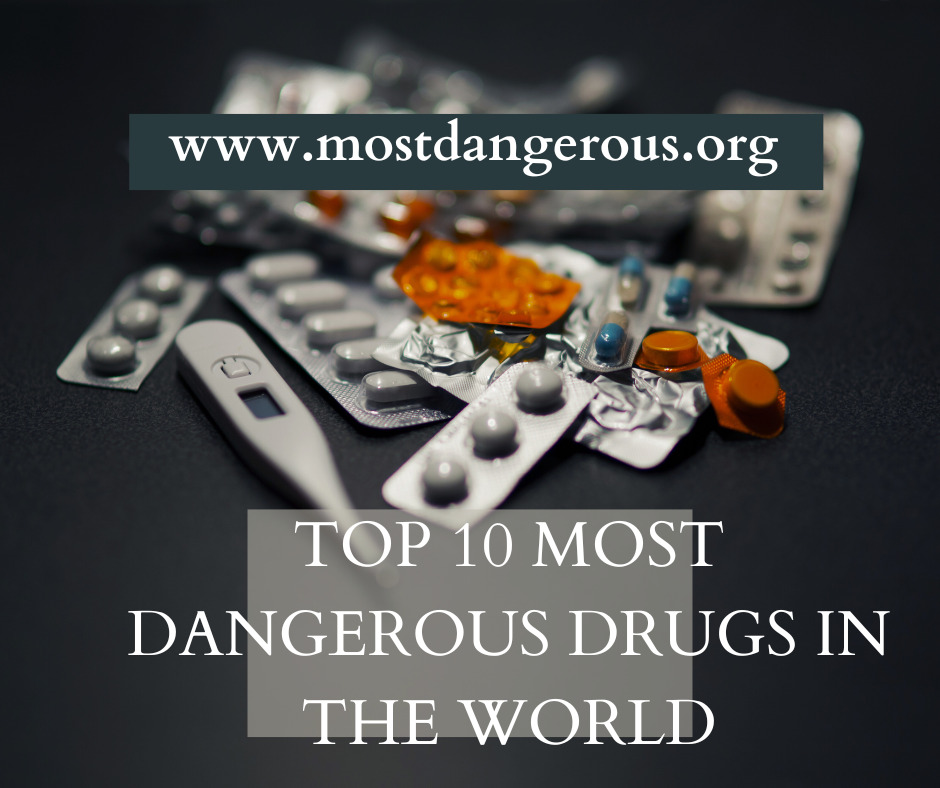In today’s society, drug use and abuse present significant challenges, impacting individuals, families, and communities worldwide.
While all drugs come with inherent risks, some substances stand out for their particularly harmful effects on health, well-being, and society at large.

In this article, we delve into the realm of pharmacology to identify and explore the ten most dangerous drugs in the world.
From their addictive potential to their devastating consequences, these substances represent some of the gravest threats facing modern society.
Top 10 Most Dangerous Drugs in the World
1. Heroin
Widely regarded as one of the most potent and addictive opioids, heroin tops the list of the most dangerous drugs.
Derived from morphine, heroin produces intense euphoria and pain relief, but its misuse can lead to respiratory depression, overdose, and death.
The risk of addiction is exceptionally high, with users often experiencing severe withdrawal symptoms when attempting to quit.

2. Methamphetamine
Methamphetamine, commonly known as meth, is a powerful stimulant that profoundly affects the central nervous system.
Its use can result in heightened alertness, increased energy, and euphoria.
However, prolonged methamphetamine abuse can lead to severe psychological and physical health issues, including addiction, psychosis, cardiovascular complications, and irreversible brain damage.

3. Cocaine
Cocaine is a stimulant drug extracted from the leaves of the coca plant. It produces a rapid onset of euphoria, energy, and confidence.
Despite its short-lived effects, cocaine carries significant risks, including addiction, heart problems, stroke, and respiratory failure.
Long-term use can also lead to severe psychological disturbances and financial ruin.
4. Fentanyl
As one of the most potent synthetic opioids, fentanyl has gained notoriety for its role in the opioid epidemic.
It is often illicitly manufactured and mixed with other drugs, contributing to a surge in overdose deaths worldwide.
Fentanyl’s potency makes it extremely dangerous, even in small doses, with a high risk of respiratory depression and overdose.
5. Alcohol
While legal and socially accepted in many cultures, alcohol ranks among the most dangerous drugs due to its widespread availability and profound health impacts.
Excessive alcohol consumption can lead to liver disease, cardiovascular problems, neurological disorders, addiction, and a host of social and behavioral issues, including violence and accidents.
6. Benzodiazepines
Benzodiazepines, such as Xanax and Valium, are central nervous system depressants prescribed to treat anxiety, insomnia, and seizures.
Despite their therapeutic benefits, benzodiazepines carry a high risk of dependence, overdose, and withdrawal symptoms.
Their combined use with other substances, particularly opioids, can be lethal.

7. Ketamine
Originally developed as an anesthetic, ketamine has gained popularity as a recreational drug for its dissociative effects.
However, ketamine abuse can lead to serious health complications, including addiction, cognitive impairment, psychosis, and bladder dysfunction.
Its illicit use poses significant risks to physical and mental well-being.
8. Synthetic Cannabinoids
Often marketed as “legal highs” or “synthetic marijuana,” synthetic cannabinoids are chemically engineered substances designed to mimic the effects of THC, the active ingredient in cannabis.
However, these synthetic compounds can be far more potent and unpredictable, leading to severe adverse reactions, including psychosis, seizures, and even death.

9. Bath Salts
Bath salts refer to a group of synthetic cathinones that produce stimulant and hallucinogenic effects similar to MDMA or cocaine.
However, bath salts are associated with a higher risk of adverse reactions, including paranoia, agitation, hallucinations, and violent behavior.
Prolonged use can result in severe medical complications and psychiatric disorders.
10. Tobacco
Despite widespread awareness of its health risks, tobacco remains one of the most prevalent and addictive drugs globally.
Nicotine, the primary psychoactive ingredient in tobacco, exerts powerful effects on the brain, leading to addiction and dependence.
Tobacco use is a leading cause of preventable death, responsible for a range of health problems, including cancer, cardiovascular disease, and respiratory disorders.
Wrapping up
The landscape of drug use and addiction is complex and multifaceted, with various substances posing significant risks to individuals and society as a whole.
By understanding the dangers associated with these ten most dangerous drugs, policymakers, healthcare professionals, and communities can develop targeted interventions and support systems to address substance abuse and promote public health and safety.
Education, prevention, and access to treatment are essential components of a comprehensive approach to tackling the global drug crisis and mitigating its devastating consequences.
ALSO READ:
